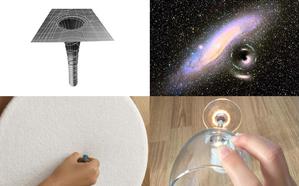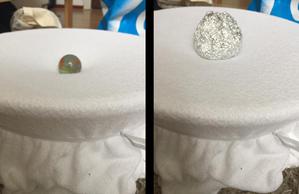Glossary term: Black Hole
Description: A black hole is a region of space where the gravitational force is so large that nothing, not even light, can escape from it.
Many galaxies, including the Milky Way, have a large black hole (known as a supermassive black hole) in their center.
One of the ways astronomers think smaller black holes form is when a massive star collapses at the end of its life. However astronomers do not yet know the origins of supermassive black holes.
The outer boundary of a black hole is known as the event horizon.
Near black holes the physics are so extreme that time runs much slower (compared to an observer far away from the black hole) and, around smaller black holes, objects are stretched and torn to pieces. Matter falling towards a black hole forms an accretion disk. This can often be accompanied by jets of matter sent out from this disk. Black hole accretion disks are the source of power of quasars and other active galactic nuclei (AGN) as well as many other X-ray sources.
Related Terms:
See this term in other languages
Term and definition status: This term and its definition have been approved by a research astronomer and a teacher
The OAE Multilingual Glossary is a project of the IAU Office of Astronomy for Education (OAE) in collaboration with the IAU Office of Astronomy Outreach (OAO). The terms and definitions were chosen, written and reviewed by a collective effort from the OAE, the OAE Centers and Nodes, the OAE National Astronomy Education Coordinators (NAECs) and other volunteers. You can find a full list of credits here. All glossary terms and their definitions are released under a Creative Commons CC BY-4.0 license and should be credited to "IAU OAE".
If you notice a factual error in this glossary definition then please get in touch.
Related Activities
Hunting for black holes
astroEDU educational activity (links to astroEDU website) Description: How do astronomers detect invisible black holes?
License: CC-BY-4.0 Creative Commons Attribution 4.0 International (CC BY 4.0) icons
Tags:
Model
, Experiment
Age Ranges:
12-14
Education Level:
Informal
, Middle School
Areas of Learning:
Modelling
, Observation based
, Problem-solving
, Social Research
Costs:
Low Cost
Duration:
45 mins
Group Size:
Group
Skills:
Constructing explanations
, Developing and using models
What is a black hole?
astroEDU educational activity (links to astroEDU website) Description: What are black holes and what would happen if the Sun was replaced by one of them?
License: CC-BY-4.0 Creative Commons Attribution 4.0 International (CC BY 4.0) icons
Tags:
Model
, Experiment
, Investigation
Age Ranges:
12-14
Education Level:
Informal
, Middle School
Areas of Learning:
Discussion Groups
, Interactive Lecture
, Modelling
, Observation based
, Problem-solving
, Social Research
Costs:
Low Cost
Duration:
45 mins
Group Size:
Group
Skills:
Constructing explanations
, Developing and using models
, Engaging in argument from evidence
, Planning and carrying out investigations
Model of a Black Hole
astroEDU educational activity (links to astroEDU website) Description: Understand the mystery of black holes through a hands-on activity.
License: CC-BY-4.0 Creative Commons Attribution 4.0 International (CC BY 4.0) icons
Tags:
Hands-on
, Model
, Interactive
, Space-time
, Black holes
Age Ranges:
8-10
, 10-12
Education Level:
Primary
, Secondary
Areas of Learning:
Modelling
, Social Research
Costs:
Medium Cost
Duration:
1 hour
Group Size:
Group
Skills:
Asking questions
, Developing and using models











